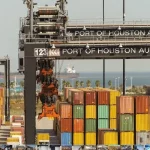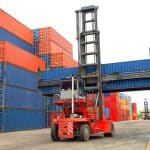DALI BOXSHIP TO BE REMOVED BY MAY 10
Officials expect to have removed the Dali containership from its lodged position in Baltimore port by May 10. The 9,962 teus ship took out the Francis Scott Key Bridge on March 26 and has been wedged onto the bed of the Patapsco River ever since. So far, 3,300 tons of debris have been removed from the river and more than 180 containers have been moved off the bow of the stricken Singapore flagged boxship. “We are talking about a massive piece of steel, and on one end, the steel is leaning against a vessel that is the size of the Eiffel Tower. On the other end, it is leaning against the bottom of the riverbed,” Wes Moore, the governor of Maryland, said at a press conference yesterday. Once the Dali returns to port, officials said they expect to open a 13.7 m channel by May 10 with the aim to fully restore the port’s 15 m deep main channel by the end of May. The National Transportation Safety Board expects to release its preliminary report on the disaster within one week.
RCL BACK FOR MORE HUANGPU WENCHONG BOXSHIPS
Thailand’s Regional Carrier Lines (RCL) has returned to CSSC-affiliated Huangpu Wenchong Shipbuilding in Guangzhou with a deal for two additional 4,400 teu vessels. The order which follows a quarter booked earlier this year at $56.6m apiece will see the latest duo delivered by November and December 2027 for the same price tag. RCL currently stands 24th on Alphaliner’s list of largest carriers, with twenty-nine owned ships in its fleet totaling 63,885 teu, and ten newbuilds which will nearly double its carrying capacity when delivered.

HOUTHI INCREASED RANGE OF ATTACK RAISES COALITION PROTECTION CONCERNS
Up to now Houthi attacks have been limited to coastal waters, mainly in the narrow Bab al-Mandeb strait and the Gulf of Aden, but the attack on the 15,000 teu MSC Orion occurred around 170 miles south of Yemeni controlled Scootra island. The change in regional operations noted by security firm Dryad Global has also come with closer ties between disparate organisations, such as Somali pirates, and Somali Islamic organisation Al-Shabaab and the Houthi movement, which is also a major development, and could prolong the blockade of the Red Sea and Suez Canal thoroughfares. As a result, Dryad Global CEO Corey Ranslem noted: “In recent months, we have seen a number of incidents involving the expansion of their operational area into the Indian Ocean.” Dryad Global also point out that the necessary defensive capabilities against drones are either unavailable or prohibitively expensive for civilian organisations, making their reliance on the coalition forces more important. According to Suarez Somali pirates collaborated with Al-Shabaab to facilitate the hijacking of the Ruen, and they worked directly with Houthi elements during the negotiations. Moreover, Suarez comments: “The hijacking and ongoing hostage situation with the crew of the Galaxy leader revealed direct links between the Houthis and Hamas. While all of these elements may not always collaborate closely, there have been reports of coordinated efforts to attack coalition and commercial vessels.”
HAPAG-LLOYD DEBUTS DRY CONTAINER TRACKING PRODUCT
Germany’s Hapag-Lloyd has become the first liner in the world to launch a fleet-wide dry container tracking product. Hapag-Lloyd’s new Live Position product provides full on-demand door-to-door visibility, using Internet of Things technology on a large scale. More than two thirds of the company’s dry container fleet have already been equipped with tracking devices with the installations expected to be completed in the next few months. Developers are now working on the product to get the tracking data into customers’ operational systems via API. Another milestone for advancing the product will be the estimated time of arrival prediction.




